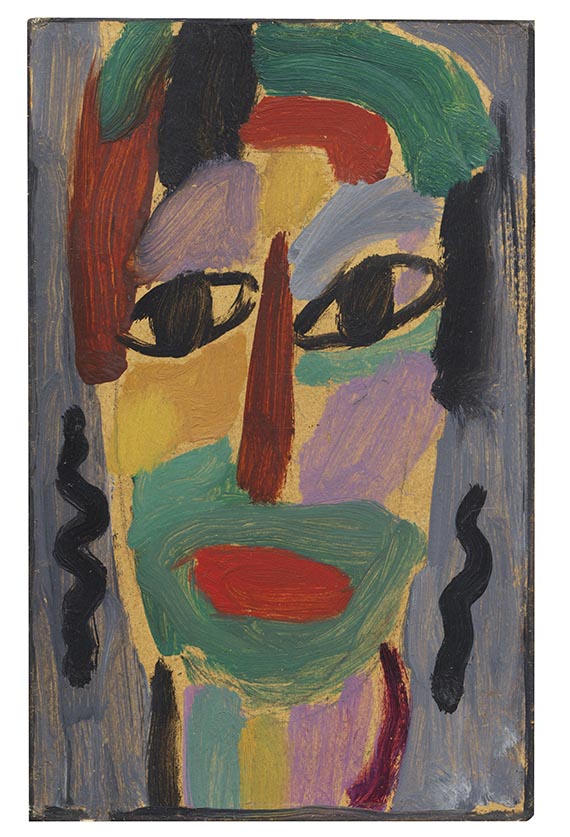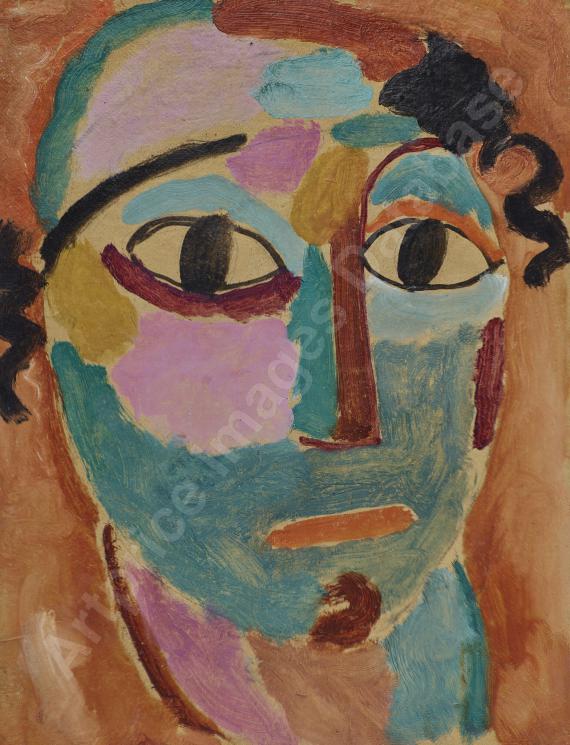Sale: 590 / Evening Sale, June 06. 2025 in Munich  Lot 125000037
Lot 125000037
 Lot 125000037
Lot 125000037
125000037
Alexej von Jawlensky
Mystischer Kopf, Um 1917.
Oil on fibreboard
Estimate:
€ 90,000 - 120,000
$ 97,200 - 129,600
Information on buyer's premium, taxation and resale right compensation will be available four weeks before the auction.
Mystischer Kopf. Um 1917.
Oil on fibreboard.
Inscribed with the artist's name on the reverse, presumably by a hand other than that of the artist, as well as dated “1917(?)” by yet another hand or by Lisa Kümmel. 25.5 x 16 cm (10 x 6.2 in).
• Captivating front view portrait from the 'Mystical Heads' series.
• During these years, the artist regained strength through the motif of the portrait head, which was central to his entire oeuvre.
• With a radically reduced formal language and a maximally liberated use of color, Jawlensky struck a fascinating balance between figuration and abstraction.
• Comparable “Mystical Heads” are part of numerous museum collections, including the Museum Morsbroich, Leverkusen, the Landesmuseum Darmstadt, the Kunstmuseum Basel and the Norton Simon Museum, Pasadena.
PROVENANCE: Lisa Kümmel, Wiesbaden.
Karl Kümmel, Wiesbaden (by descent, 1944).
Galerie Thomas, Munich (from 1978, on commission from the above).
Private collection, North Rhine-Westphalia.
Private collection, South Germany.
EXHIBITION: Unbekannte Arbeiten, Galerie Thomas, Munich, February 3 - March 25, 1978, p. 27 (illustrated in color on p. 28).
LITERATURE: Maria Jawlensky/Lucia Pieroni-Jawlensky/Angelica Jawlensky, Alexej Jawlensky. Catalogue Raisonné of the Oil Paintings, vol. II: 1914-1933, Munich 1992, p. 225, cat. rais. no. 923 (illustrated in black and white).
- -
Nagel Auktionen, Stuttgart, October 18, 2002, p. 159, lot 538 (illustrated).
Villa Grisebach Auktionen, Berlin, June 11, 2004, lot 30 (illustrated).
Oil on fibreboard.
Inscribed with the artist's name on the reverse, presumably by a hand other than that of the artist, as well as dated “1917(?)” by yet another hand or by Lisa Kümmel. 25.5 x 16 cm (10 x 6.2 in).
• Captivating front view portrait from the 'Mystical Heads' series.
• During these years, the artist regained strength through the motif of the portrait head, which was central to his entire oeuvre.
• With a radically reduced formal language and a maximally liberated use of color, Jawlensky struck a fascinating balance between figuration and abstraction.
• Comparable “Mystical Heads” are part of numerous museum collections, including the Museum Morsbroich, Leverkusen, the Landesmuseum Darmstadt, the Kunstmuseum Basel and the Norton Simon Museum, Pasadena.
PROVENANCE: Lisa Kümmel, Wiesbaden.
Karl Kümmel, Wiesbaden (by descent, 1944).
Galerie Thomas, Munich (from 1978, on commission from the above).
Private collection, North Rhine-Westphalia.
Private collection, South Germany.
EXHIBITION: Unbekannte Arbeiten, Galerie Thomas, Munich, February 3 - March 25, 1978, p. 27 (illustrated in color on p. 28).
LITERATURE: Maria Jawlensky/Lucia Pieroni-Jawlensky/Angelica Jawlensky, Alexej Jawlensky. Catalogue Raisonné of the Oil Paintings, vol. II: 1914-1933, Munich 1992, p. 225, cat. rais. no. 923 (illustrated in black and white).
- -
Nagel Auktionen, Stuttgart, October 18, 2002, p. 159, lot 538 (illustrated).
Villa Grisebach Auktionen, Berlin, June 11, 2004, lot 30 (illustrated).
When World War I broke out, Alexej von Jawlensky, as a Russian citizen, was forced to leave Germany in 1914. Together with his partner Marianne von Werefkin and his companion Helene Nesnakomoff, the artist went into exile in Switzerland. Until 1917 they lived in a small house in Saint-Prex on Lake Geneva. This eventful time marked a turning point not only in his private life but also in his art: “In our little apartment there, I only had a small room to work in with a window. I wanted to paint my powerful, strongly colored pictures, but I felt I couldn't. My soul didn't allow me this sensual painting, even though there is a lot of beauty in my work [...] I now began to look for a new path in art. It was a great work. [...] My formats became smaller.” (Alexej von Jawlensky, Erinnerungen, quoted from: https://www.lenbachhaus.de/digital/sammlung-online/detail/nacht-in-st-prex-30005164).
“My soul had been changed by much suffering, and that demanded finding different forms and colors to express what moved my soul [...] Through hard work and with the greatest concentration, I gradually found the right colors and forms to express what my spiritual self demanded.” (Alexej von Jawlensky, ibid., quoted from: Clemens Weiler, Alexej Jawlensky, Hanau 1970, p. 116).
Now numerous abstract landscape representations are emerging, based on his immediate surroundings, the series of “Variations”. From October 1917, the artist also occupied himself with his favorite motif of the human head and initially seems to have drawn on his brightly colored and expressively designed heads from the pre-war years, such as “Reife” (c. 1912, Städtische Galerie im Lenbachhaus, Munich).
And so the first, further developed “Mystical Heads” emerged, which in the following years formed a complex series of works that was relatively small in the context of his other serial works. In these works, Jawlensky simplifies the human face; the physiognomies are abstracted, de-individualized and stylized: bold fields of color as well as striking monochrome lines and beams mark the eyebrows, mouth, bridge of the nose, cheeks and hairline.
In the work offered here, the focus is solely on the frontally aligned face. The strong, bright colors used here also attest to the influence of the French avant-garde at the time, particularly the “Fauves”, and further help the depictions in their overcoming of reality.
In their stylization, simplified motifs and formal reduction, the “Mystical Heads” are a pioneering key moment in Jawlensky's programmatic path between figuration and abstraction, which was continued with the subsequent comprehensive groups of works, the “Faces of the Saviour” and the “Christ Heads” , and later in the “Abstract Heads” and finally in the highly simplified “Meditations”, which culminates in the greatest possible abstraction in the artist's oeuvre. It is in this exciting in-between space that the distinctiveness and extraordinary modernity of Jawlensky's unique painting still lies today. [CH]
“My soul had been changed by much suffering, and that demanded finding different forms and colors to express what moved my soul [...] Through hard work and with the greatest concentration, I gradually found the right colors and forms to express what my spiritual self demanded.” (Alexej von Jawlensky, ibid., quoted from: Clemens Weiler, Alexej Jawlensky, Hanau 1970, p. 116).
Now numerous abstract landscape representations are emerging, based on his immediate surroundings, the series of “Variations”. From October 1917, the artist also occupied himself with his favorite motif of the human head and initially seems to have drawn on his brightly colored and expressively designed heads from the pre-war years, such as “Reife” (c. 1912, Städtische Galerie im Lenbachhaus, Munich).
And so the first, further developed “Mystical Heads” emerged, which in the following years formed a complex series of works that was relatively small in the context of his other serial works. In these works, Jawlensky simplifies the human face; the physiognomies are abstracted, de-individualized and stylized: bold fields of color as well as striking monochrome lines and beams mark the eyebrows, mouth, bridge of the nose, cheeks and hairline.
In the work offered here, the focus is solely on the frontally aligned face. The strong, bright colors used here also attest to the influence of the French avant-garde at the time, particularly the “Fauves”, and further help the depictions in their overcoming of reality.
In their stylization, simplified motifs and formal reduction, the “Mystical Heads” are a pioneering key moment in Jawlensky's programmatic path between figuration and abstraction, which was continued with the subsequent comprehensive groups of works, the “Faces of the Saviour” and the “Christ Heads” , and later in the “Abstract Heads” and finally in the highly simplified “Meditations”, which culminates in the greatest possible abstraction in the artist's oeuvre. It is in this exciting in-between space that the distinctiveness and extraordinary modernity of Jawlensky's unique painting still lies today. [CH]
125000037
Alexej von Jawlensky
Mystischer Kopf, Um 1917.
Oil on fibreboard
Estimate:
€ 90,000 - 120,000
$ 97,200 - 129,600
Information on buyer's premium, taxation and resale right compensation will be available four weeks before the auction.
Headquarters
Joseph-Wild-Str. 18
81829 Munich
Phone: +49 89 55 244-0
Fax: +49 89 55 244-177
info@kettererkunst.de
Louisa von Saucken / Christoph Calaminus
Holstenwall 5
20355 Hamburg
Phone: +49 40 37 49 61-0
Fax: +49 40 37 49 61-66
infohamburg@kettererkunst.de
Dr. Simone Wiechers / Nane Schlage
Fasanenstr. 70
10719 Berlin
Phone: +49 30 88 67 53-63
Fax: +49 30 88 67 56-43
infoberlin@kettererkunst.de
Cordula Lichtenberg
Gertrudenstraße 24-28
50667 Cologne
Phone: +49 221 510 908-15
infokoeln@kettererkunst.de
Hessen
Rhineland-Palatinate
Miriam Heß
Phone: +49 62 21 58 80-038
Fax: +49 62 21 58 80-595
infoheidelberg@kettererkunst.de
We will inform you in time.









